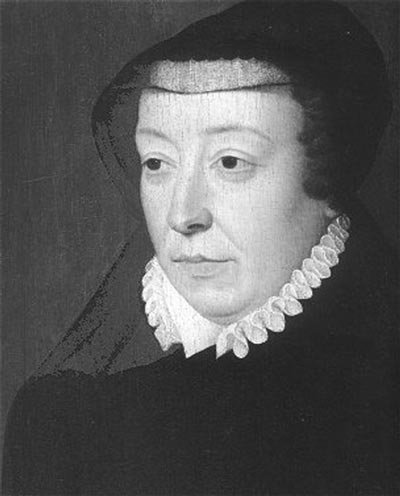Born: April 13, 1519, Florence
Died: January 5, 1589, Blois, France

Catherine de Médicis was the queen of France (1547-1559) and mother of the last three Valois kings of France. She was a major force in French politics during the 30 years of Roman Catholic-Huguenot wars and an instigator of the Massacre of Saint Bartholomew’s Day.
Catherine was born on April 13, 1519, in Florence, Italy, the daughter of Lorenzo, Duke of Urbino, and the great-grand-daughter of the Florentine ruler Lorenzo de’ Medici, called Lorenzo the Magnificent. In 1533 she married the duc d’Orléans, who became king of France in 1547 as Henry II. She had little power during the reign of her husband and that of her first son, Francis II, but on Francis’s death in 1560 the government fell entirely into her hands. She ruled as regent for her second son, Charles IX, until he reached his majority in 1563, and she continued to dominate him for the duration of his reign.
In her determination to preserve royal power at any cost, Catherine devoted her energies to maintain a balance between the Protestant group known as the Huguenots, led by the French military leader Count Châtillon, and the Roman Catholics, led by the powerful house of Guise. During the religious civil wars that began in 1562. Catherine, a Roman Catholic, usually supported the Catholics; sometimes, however, political expediency led her to switch her support to the Huguenots. Her political manipulations also affected the personal affairs of her family. In 1560 she arranged for her daughter, Elizabeth of Valois, to become the third wife of the powerful Roman Catholic king of Spain, Philip II. In 1572, Catherine found it propitious to marry another daughter, Margaret of Valois, to the Protestant king Henry of Navarre, who later became Henry IV, king of France. Later in 1572, she found the growing Huguenot influence over her son Charles, the French king, frightening; accordingly, she instigated the plot to assassinate the Protestant leader Count Châtillon that led to his death and the deaths of an estimated 50,000 other Huguenots in the Massacre of Saint Bartholomew’s Day. After the death of Charles in 1574 and the accession to the throne of her third son as Henry III, Catherine’s power declined. She died in Blois, France, on January 5, 1589.
Apart from her political role, Catherine was a patron of the arts. Her interest in architecture was demonstrated in the building of a new wing of the Louvre Museum, in initiating the construction of the Tuileries gardens, and in building the château of Monceau. Her personal library, containing numerous rare manuscripts, was renowned in Renaissance France.
